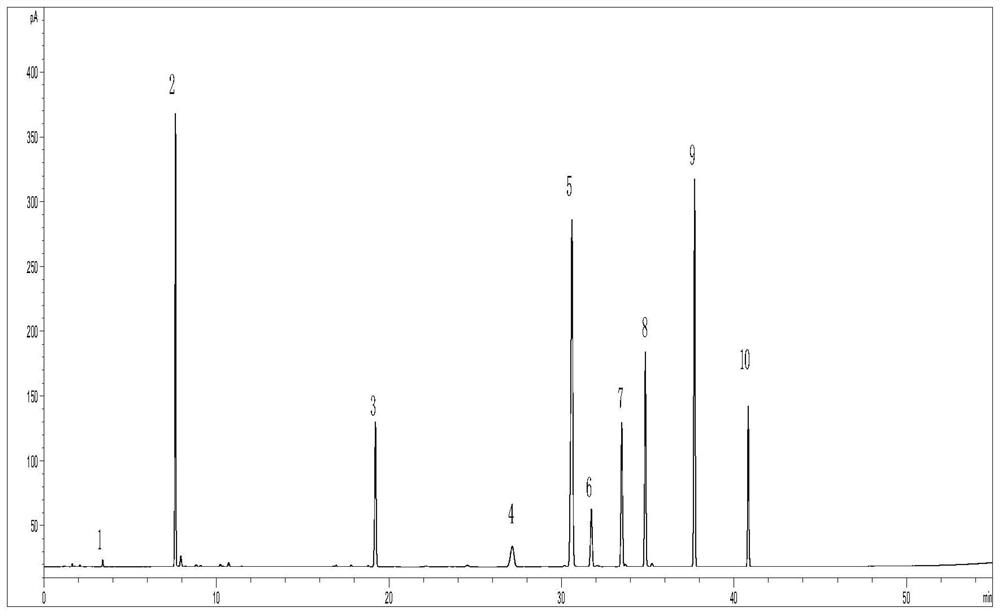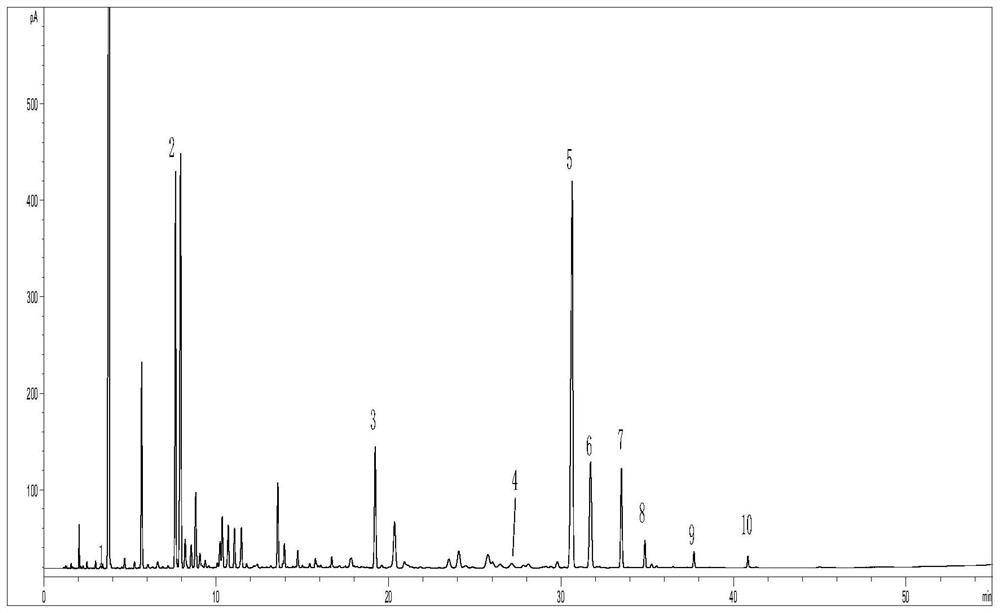A method for detecting the content of aroma components in roses
A technology of aroma components and detection methods, which is applied in the field of chemical detection, can solve the problems of high technical requirements for testing personnel, high requirements for testing instruments, and high cost of reference substances, and achieve the effects of improving measurement efficiency, cheap solvents, and accurate and reliable measurement results
- Summary
- Abstract
- Description
- Claims
- Application Information
AI Technical Summary
Problems solved by technology
Method used
Image
Examples
Embodiment 1
[0061] Preparation of internal standard solution: Accurately weigh 0.2g of n-butanol, add 5-15°C ultrapure water to dissolve and set the volume to 100ml;
[0062] Preparation of the test solution: Take an appropriate amount of rose petals, cut them into 1cm at 5-15°C 2 For the following fragments, weigh 4g of broken rose petals, put them in a 20ml headspace bottle, then use a pipette to take 5ml of 1-2mg / ml n-butanol aqueous solution at 5-15°C, cover and seal, and then you can get the test product solution.
[0063] Preparation of reference substance solution: Accurately weigh 0.03 g of citronellol reference substance, place it in a headspace bottle, add 5 ml of internal standard solution, and seal it with a cap;
[0064] Preparation of mixed reference substance solution: Accurately weigh 0.1-1.5 g of geraniol, 0.05-0.8 g of nerol, 0.15-1.8 g of 2-phenylethyl alcohol, 0.15-1.7 g of eugenol, and 0.2 g of eugenol methyl ether according to the weight gradient. ~2.5g, linalool 0...
Embodiment 2
[0074] Preparation of internal standard solution: Accurately weigh 0.1g of n-butanol, add 5-15°C ultrapure water to dissolve and set the volume to 100ml;
[0075] Preparation of the test solution: Take an appropriate amount of rose petals, cut them into 1cm at 5-15°C 2 For the following fragments, weigh 4.5g of broken rose petals, put them in a 20ml headspace bottle, then use a pipette to take 5ml of 1-2mg / ml n-butanol aqueous solution at 5-15°C, cover and seal, and obtain Test solution.
[0076] Preparation of reference substance solution: Accurately weigh 0.04g of citronellol as reference substance, place it in a headspace bottle, add 5ml of internal standard solution, and seal it with a cap;
[0077] Preparation of mixed reference substance solution: Accurately weigh 0.1-1.5 g of geraniol, 0.05-0.8 g of nerol, 0.15-1.8 g of 2-phenylethyl alcohol, 0.15-1.7 g of eugenol, and 0.2 g of eugenol methyl ether according to the weight gradient. ~2.5g, linalool 0.02~0.5g, citronell...
Embodiment 3
[0087] Preparation of internal standard solution: Accurately weigh 0.1g of n-butanol, add 5-15°C ultrapure water to dissolve and set the volume to 100ml;
[0088] Preparation of the test solution: Take an appropriate amount of rose petals, cut them into 1cm at 5-15°C 2 For the following fragments, weigh 5.0g of broken rose petals, put them in a 20ml headspace bottle, then use a pipette to take 5ml of 1mg / ml n-butanol aqueous solution at 5-15°C, cover and seal, to obtain the test product solution.
[0089] Preparation of reference substance solution: Accurately weigh 0.05 g of citronellol reference substance, place it in a headspace bottle, add 5 ml of internal standard solution, and seal it with a cap;
[0090] Preparation of mixed reference substance solution: Accurately weigh 0.1-1.5 g of geraniol, 0.05-0.8 g of nerol, 0.15-1.8 g of 2-phenylethyl alcohol, 0.15-1.7 g of eugenol, and 0.2 g of eugenol methyl ether according to the weight gradient. ~2.5g, linalool 0.02~0.5g, c...
PUM
| Property | Measurement | Unit |
|---|---|---|
| length | aaaaa | aaaaa |
| thickness | aaaaa | aaaaa |
Abstract
Description
Claims
Application Information
 Login to View More
Login to View More - R&D
- Intellectual Property
- Life Sciences
- Materials
- Tech Scout
- Unparalleled Data Quality
- Higher Quality Content
- 60% Fewer Hallucinations
Browse by: Latest US Patents, China's latest patents, Technical Efficacy Thesaurus, Application Domain, Technology Topic, Popular Technical Reports.
© 2025 PatSnap. All rights reserved.Legal|Privacy policy|Modern Slavery Act Transparency Statement|Sitemap|About US| Contact US: help@patsnap.com



